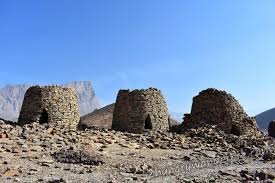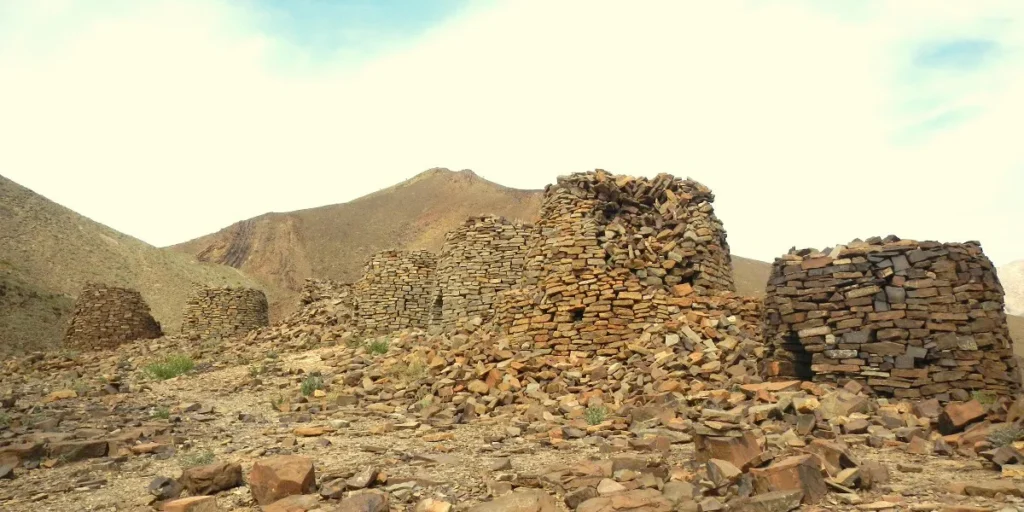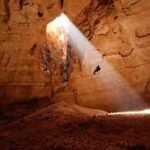Just 40 kilometers southwest of Muscat’s modern skyline lies one of Arabia’s most enigmatic prehistoric sites – the Al Wattih stone circles, often called “Oman’s Stonehenge.” This complex of 100+ stone formations dates back over 5,000 years to the Hafit Period (3100-2700 BCE), predating both the Pyramids of Giza and its British counterpart. Unlike solitary standing stones seen elsewhere, Al Wattih features intricate concentric circles, burial cairns, and a central “observatory” structure aligned with celestial events. The site’s true purpose remains debated, but recent excavations reveal it was likely an astronomical calendar, burial complex, and ritual center for Oman’s earliest metalworking culture. What makes Al Wattih extraordinary are the petroglyphs found on certain stones depicting constellations unknown to modern astronomy, along with copper slag deposits suggesting metallurgical rituals under specific cosmic alignments. Local Bedouin have long considered the area haunted, speaking of “blue lights” that dance between the stones during lunar eclipses and strange magnetic anomalies that disrupt compasses within the circles.
The Architecture of Time: Al Wattih is Celestial Alignments
Al Wattih’s stone circles demonstrate sophisticated understanding of astronomy millennia before telescopes. The central formation contains 22 upright slabs arranged in a perfect circle with a 7-meter diameter, each stone precisely positioned to mark solar and lunar events. During summer solstice sunrise, shadows cast by the northeast stones form a dagger-like shape that pierces the center of a carved spiral petroglyph. Equinox sunrises align with a narrow corridor formed by two parallel stone rows leading to a ceremonial platform. Most intriguing is the “moon stone” – a flat basalt slab that resonates with a peculiar metallic tone when struck, positioned to catch the northernmost moonrise during its 18.6-year cycle. French archaeologist Dr. Sylvie Méry discovered in 2018 that certain stone groupings form accurate sightlines to bright stars used for navigation by early seafarers, suggesting Al Wattih may have been a training ground for Oman’s first maritime explorers. The stones themselves tell a geological story – sourced from five different quarries across northern Oman and transported using techniques still not fully understood.
Al Wattih The Copper Connection: Metallurgy and the Cosmos
Excavations around Al Wattih have uncovered something unexpected – extensive evidence of ancient copper smelting. Over 200 ceramic crucible fragments and tons of slag reveal the site was an important metalworking center during the Umm an-Nar period (2500-2000 BCE). What’s peculiar is the metallurgical debris’s distribution: concentrated in specific areas corresponding to astronomical alignments. Archaeometallurgists found that smelting occurred primarily during dawn on summer solstices, with crucibles placed to catch the first sunlight. This ritualistic timing suggests Oman’s early metalworkers believed cosmic forces influenced their craft. The most startling discovery came in 2021 when X-ray fluorescence revealed traces of meteoric iron in several slag samples – evidence these ancient smiths may have worked with “sky metal” they considered divinely bestowed. Local legends speak of a “fallen star forge” at Al Wattih, where weapons were made that “could cut through jinn.” Modern experiments show the site’s unique acoustics amplify the sounds of metalworking, creating an otherworldly chorus when multiple anvils are struck simultaneously – possibly explaining ancient accounts of “singing stones.”
The Lost Constellations of Al Wattih is Petroglyphs
Among Al Wattih’s most baffling features are the celestial petroglyphs carved into certain stones. While some depict recognizable constellations like Orion and Pleiades, others show star patterns unknown to modern astronomy. German archaeoastronomer Dr. Frank Preusser identified 17 unique configurations that may represent: extinct supernovae visible 5,000 years ago; asterisms important to ancient navigation; or even symbolic representations of deities. One recurring motif shows a “broken circle” of stars with a central dot – possibly recording the Crab Nebula’s supernova explosion observed in 1054 BCE, though this would mean the carvings were updated over millennia. Even more mysterious are the “star maps” showing precise arrangements that computer simulations reveal matched Oman’s night sky during the Bronze Age, but only when viewed from specific observation points within the circles. This suggests Al Wattih’s builders possessed advanced knowledge of parallax and observational astronomy. Local tribes still tell stories of ancestors who “read the sky like a shepherd reads tracks,” using these stones to predict weather patterns and guide caravans.

The Discovery and Modern Excavations
Al Wattih was first documented in the 1980s by Omani oil surveyors who noticed unusual circular patterns in aerial photos. Proper archaeological work began only in 2007 when a joint Omani-French team uncovered the astronomical alignments. The site gained international attention in 2015 with the discovery of a “star chamber” – a buried stone-lined pit containing 22 carved stone spheres arranged in patterns matching Orion’s Belt at different epochs. Recent ground-penetrating radar has revealed an extensive underground network of channels and chambers yet to be excavated, including what appears to be a ritual pool aligned with the winter solstice sunset. Each excavation season brings new surprises: in 2022, researchers found a cache of copper “tally sticks” notched in groups of 29 – likely a lunar phase counting system. The ongoing work suggests Al Wattih was continuously used and modified for over 3,000 years, making it far more than a simple calendar – it was a living astronomical computer that evolved with its users’ growing knowledge of the cosmos.
The Supernatural Lore of the Singing Stones
Al Wattih’s modern reputation as a haunted site stems from both ancient legends and contemporary encounters. Jebali tribespeople speak of the “blue jinn of Al Wattih” – spirits said to gather at the stones during moonless nights. Several archaeologists have reported equipment malfunctions, with cameras capturing strange light streaks and audio recorders picking up faint chanting sounds with no visible source. The most documented phenomenon is the “singing stones” effect – certain rocks emit metallic ringing tones when the desert wind reaches specific speeds, creating an eerie natural orchestra. Geologists attribute this to eroded cavities in the basalt, but the consistency of the tones (which form a pentatonic scale) seems improbably precise. Nighttime visitors describe an oppressive silence within the central circle, where even the wind seems muted. In 2019, a team from Sultan Qaboos University measured brief but intense electromagnetic pulses originating from the site’s center during predawn hours – readings that spiked dramatically during meteor showers. Whether these phenomena have natural explanations or not, they’ve ensured Al Wattih remains wrapped in supernatural mystique for both locals and researchers.
Visiting Al Wattih Today: Guidelines and Mysteries
Access to Al Wattih requires permits from Oman’s Ministry of Heritage and Tourism, with official guides mandatory to protect the fragile site. The best viewing occurs at sunrise during equinoxes (March/September) when alignments are most visible. Visitors must stay on marked paths to avoid damaging undiscovered subsurface features. What makes Al Wattih uniquely engaging is its interactivity – standing in the central circle during solstice, one can literally watch astronomy become archaeology as sunlight precisely bisects ancient stones. The nearby visitor center displays excavated artifacts including the mysterious stone spheres and copper ritual objects. For those who can’t visit physically, Oman’s Ministry has created an immersive VR experience replicating the site’s alignments through history. Whether you come as pilgrim, scientist, or curious traveler, Al Wattih offers a rare opportunity to stand where Bronze Age minds decoded the cosmos – their stone computer still keeping some secrets after five millennia.
Why Oman’s Stonehenge Matters Today
In an age of satellite navigation and atomic clocks, Al Wattih reminds us of humanity’s enduring fascination with the heavens. The site represents a pivotal moment when hunter-gatherers transitioned to settled societies guided by celestial cycles. Its copper-smelting evidence suggests Oman’s early metallurgists saw cosmic connections in their craft – a poetic foreshadowing of how modern astronomy relies on metal telescopes. For Omanis, Al Wattih is a source of national pride, proving their ancestors were sophisticated astronomers millennia before oil discoveries. Scientists value the site as an open-air laboratory for archaeoastronomy, with alignments so precise they’ve helped recalibrate models of Earth’s axial tilt over millennia. Perhaps most importantly, Al Wattih stands as a testament to universal human curiosity – our timeless drive to read the sky’s stories and find our place in the cosmos. As excavations continue, each stone turned may reveal new chapters in the epic of how desert nomads became celestial navigators, their legacy written not on parchment, but in the silent language of aligned stones waiting for dawn’s first light.
The stones don’t reveal their secrets easily, but patient observation shows their genius – how ancient astronomers turned rock alignments into a calendar, a calculator, and perhaps a conduit between earth and sky. In our rush toward digital futures, Al Wattih whispers that some truths are best understood slowly, through seasons of observation, with feet planted firmly on earth while gazing at the stars. Its greatest lesson may be that true knowledge stands the test of time – like these silent sentinels that have watched five thousand years of sunrises, and will likely watch five thousand more.
Go to main page


